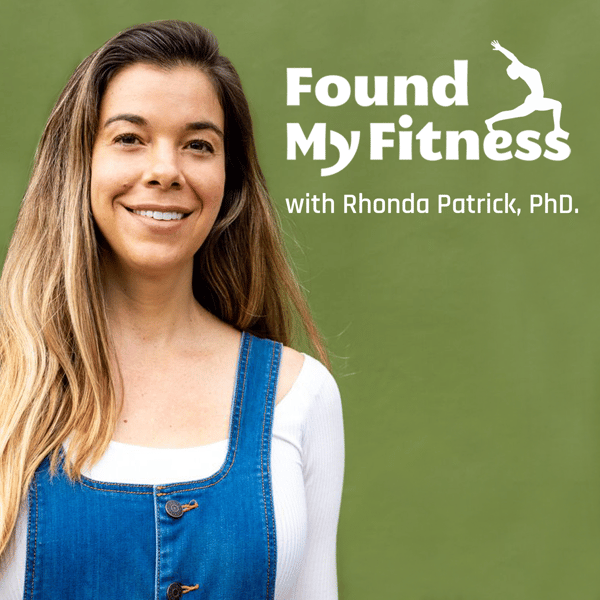#035 Gordon Lithgow, Ph.D. on Protein Aggregation, Iron Overload & the Search for Longevity Compounds
FoundMyFitness
Rhonda Patrick, Ph.D.
4.8 • 5.5K Ratings
🗓️ 4 April 2017
⏱️ 47 minutes
🧾️ Download transcript
Summary
Dr. Gordon Lithgow of the Buck Institute for Research on Aging tells us about worms!
This unassuming scientific model has a lot of important advantages for science: they can be frozen and subsequently thawed and retain viability, they are extremely well understood down to the precise number of cells in their body and the wiring of their nervous system, known as the connectome. Additionally, they have a short lifespan and are cheap to work with. Why would that be advantageous, you may ask?
This is where Dr. Lithgow's work on the Caenorhabditis Intervention Testing Program comes in. Short-lived organisms give Dr. Lithgow and his colleagues the opportunity to see how their biology responds to compounds in different contexts and to do so cheaply and rapidly. Think a vitamin, pharmaceutical or one of any number of other compounds may have a broad effect on longevity? Try it on Caenorhabditis first! Taking this approach allows the broad screening of compounds that might not otherwise get its chance in the limelight if science were limited to only working with rodents, for example.
In this episode, you'll discover:
- 00:00:00 - Introduction
- 00:03:30 - What is C elegans and why do researchers use it?
- 00:06:43 - Proteostasis and its involvement in aging
- 00:10:59 - Shocking worms with heat extends their lifespan
- 00:16:40 - Sauna use activates human heat-shock proteins, improving health
- 00:19:27 - Excess dietary iron accelerates protein aggregation, promoting Alzheimer's and Parkinson's diseases
- 00:25:07 - Vitamin D deficiency accelerates aging
- 00:35:19 - Using worms to search for compounds that extend life in humans
If you’re interested in learning more, you can read the full show notes here: https://www.foundmyfitness.com/episodes/gordon-j-lithgow
Join over 300,000 people and get the latest distilled information straight to your inbox weekly: https://www.foundmyfitness.com/newsletter
Become a FoundMyFitness premium member to get access to exclusive episodes, emails, live Q+A’s with Rhonda and more: https://www.foundmyfitness.com/crowdsponsor
Transcript
Click on a timestamp to play from that location
| 0:00.0 | Welcome back again. Today's podcast takes a dive into the world of aging research, |
| 0:05.1 | but from a perspective of lower organisms. Now you may ask yourself, what do I have in common |
| 0:09.7 | with something like a tiny nematode worm? And the answer to that is gene homology. In fact, |
| 0:16.0 | Cedar Rapiditis elegans or C elegans, as they are known, about 35% of their genes have human |
| 0:21.8 | homologues, which means that a version is also found in humans. The beauty of a model like C elegans |
| 0:27.6 | in aging research, as you will learn in this conversation with Dr. Gordon-Lithgaugh, |
| 0:31.6 | is that these animals have a very short lifespan. That means that, in comparison to more long-lived |
| 0:36.9 | higher-order organisms like rodents, it's a bit more straightforward to change up the conditions |
| 0:41.7 | and see what happens to their lifespans. You can do this more quickly and more cheaply. By way of |
| 0:46.8 | example, you might try adding in something like even a small amount of environmental stress, which, |
| 0:51.2 | if we're talking about heat stress, actually was shown to increase lifespan in worms when used |
| 0:55.6 | in the right dose. And discovery that, as we'll discuss, Dr. Gordon-Lithgaugh, today's guest, |
| 1:00.8 | actually made in the course of his research back in 1995. But it's also practically useful for |
| 1:05.6 | determining of certain compounds, including vitamins, may be candidates for increasing lifespan as well. |
| 1:11.1 | This is where the Cedar Rapiditis intervention testing program comes in. The Cedar Rapiditis |
| 1:15.6 | intervention testing program is a multi-institution effort sponsored by the National Institute on |
| 1:20.1 | Aging, a division of the NIH, designed to screen bioactive compounds for their ability to extend |
| 1:25.6 | lifespan and enhance health, using nematodes as a model system for potential effects. The Cedar |
| 1:31.8 | Rapiditis intervention testing program is actually a spin-off of another program, more simply called |
| 1:37.4 | the intervention testing program, which began in the early 2000s to look at the potential |
| 1:42.2 | for various interventions, including vitamins and pharmaceuticals and otherwise, |
| 1:46.2 | to extend the lifespan of mice. While mice are much more genetically close to us, |
... |
Please login to see the full transcript.
Disclaimer: The podcast and artwork embedded on this page are from Rhonda Patrick, Ph.D., and are the property of its owner and not affiliated with or endorsed by Tapesearch.
Generated transcripts are the property of Rhonda Patrick, Ph.D. and are distributed freely under the Fair Use doctrine. Transcripts generated by Tapesearch are not guaranteed to be accurate.
Copyright © Tapesearch 2025.

